Just getting to meet up with Kevin Staut was exciting enough. For some reason our normally trusty GPS refused to admit that the road where the training centre is based actually existed. Our phone rang, it was Kevin on the line. “Weren’t we supposed to meet half an hour ago…” “We certainly were but our GPS won’t tell us where you are…” “Where are you?” “Not sure but there is a big white marble crucifix on a stand right next to us.” “Don’t move.”
Next thing you know, a motor scooter is puttering around the corner, and a sweetly smiling Kevin Staut – who had every reason to be a little grumpy having to wait on us – was ready to show us around Haras de la Chesnaye.
Earlier in the day we had visited the breeding arm of the HDC operation, the Haras des Coudrettes, where one of the young horse trainers, Julie Gadel, had shown us around one of the most beautiful old studs we have ever visited, with paddocks filled with youngstock with mouthwatering pedigrees. Like the chestnut two-year-old colt, by Orient Express out of a Kannan mare.
Orient Express is a really exciting stallion by Quick Star, who is currently starring in the competition arena with one of the HDC riders, Patrice Delaveau, and with the WEG in Caen as the immediate aim, his breeding commitments have been severely limited.
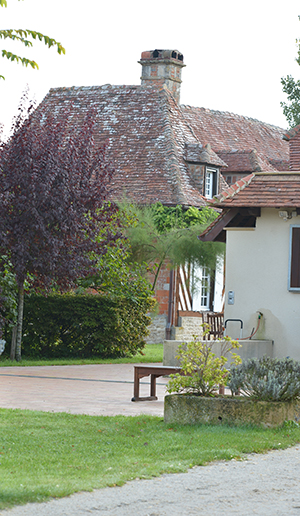
Beautiful buildings at Haras des Coudrettes
Julie explains that HDC is the creation of Armand and Emmanuelle Pette. Initially the riding interest was from Mrs Pette who bought a ‘nice horse to ride’ and the interest ballooned, and when we arrived Julie was helping the daughter, Sarah, school her horse.
Julie had been recruited by Mrs Pette from Club Mediterranee, in the early days of their equine adventures. It was a good choice since Julie has helped prepare some young stars, including the current Selle Français six-year-old champion, Twenty du Plessis (by Parco out of a For Pleasure mare) and the current five-year-old champion, Tallyne de la Pomme (Mr Blue out of a Royal Ardent mare) but it was time for our ill-fated effort to go in search of Kevin Staut, at the other HDC base… or as we were to learn, the second base, with a third under construction.
We followed Kevin and his scooter to a state-of-the-art facility – huge outdoor, huge indoor, perfectly designed stables, but Kevin explained, a new training centre was currently under construction and the Haras de la Chesnaye would become a training and sales barn, with lovely apartments available for riders who wanted to come and base and train and compete (Aussie jumpers are you listening?)
Kevin is one of the world’s top showjumpers, he is also the sort of interview that makes the journalist’s work a joy.
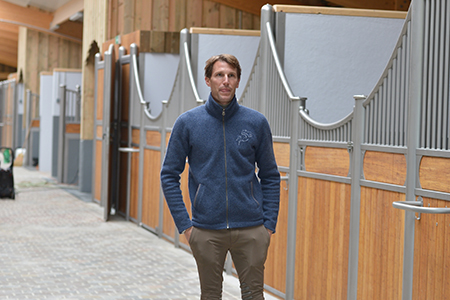
I was really impressed when I saw that you were going to Cambodia for Justworld International, because we don’t really think of showjumpers caring about anything except money…
“We need money to do our sport, we are fighting for the money to find some good horses, and to keep them with owners and sponsors, but yes, I had the opportunity with Justworld International to go to Cambodia. It was hard to find the time, to find five free days is not so easy because we have a competition every weekend. I had been thinking about it for a long time, and finally found some time.’
“First of all I did it for my small sister, she is 14 years old. She was adopted when she was four months old, and she had never been back to Cambodia. I said to her, I have no shows, so I suggested to my father that I could bring my sister with me, I thought it would be a nice trip for her. In the beginning – to be honest – I was not motivated at all to go: twenty hours to go, twenty hours to come back, to just have a few days in Cambodia, that was really not exciting for me.”
“But I did it for my sister, and eventually when I arrived in Phnom Penh, it was something you really can’t explain. I am lucky, I am doing shows all around the world, traveling a lot, and I have seen some poor countries. You feel sad when you go to a poor country, and when I arrived in Cambodia, okay it is an Asian country that has been developing a lot in the last ten years, but it is still a poor country, and you can see that when you arrive. But people are really happy – okay they see a lot of tourists with nice clothes, nice watches – but they are not jealous about this. I think it is a very good education system. Justworld is working to help the education system for the poor people. All the money Justworld is giving is to an association called PIO, which runs three schools for more than 1000 students, for children who have no parents or who are very poor. There were children from four to 16 or 17, they are smiling all the time, they are happy to go to school and get an education – to have food and to have water, that is something. They are fighting, they still have dreams.”
“They know they have a big chance with education to find something, to come out of the poor family where they have been born.”
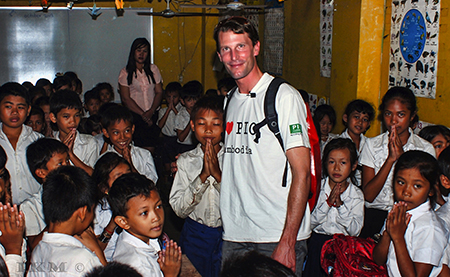
Kevin with the children in Cambodia (Photo Ian Miller)
You donate some of your prizemoney to Justworld?
“I did and I will continue for sure. It is more than to give money, I think people should go to these countries and see what it is like. Now I am sure that with education we can change a lot. Even in our countries in Europe, in France for instance, my sister she is a real teenager, always thinking about guys, about playing with computers, facebook – not at all to go to school and be serious. Then when she went to Cambodia, on the way back she told me, yeah okay, it is stupid, we have everything, we have really good facilities and we are still complaining and with no motivation at all.”
“I really think it is a problem from our education system, young people here in France are not motivated any more. When you are not fighting to get something, that’s a problem, we are lucky in equestrian sport because when you ride in this world you have to fight. We are lucky in equestrian sport there are still some very good young people who are well educated, but for the normal education system, I think it is really difficult and the children are not motivated to utilize what they have and the possibilities they have.”
Did you always want to be a showjumping rider?
“No, I started when I was ten years old, not so young. Each weekend, we came to Normandy from Paris – and you would see a lot of fields and horses all around. I was always really attracted by animals. I wanted to ride because I wanted to be really close to the horse. In the beginning I was really interested in grooming them. I wanted to be with them, to prepare them and take care of them, the riding part was not the most exciting part for me.”
“I was lucky my family spent time and money so I could realize myself in this sport, so in the beginning, it was for them that I tried to go into competition and ride in the sport. Around sixteen years old, I started to get some good results and I started to get the spirit of competition – so I said to my family, I don’t want to go to school any more, I will study at home, early in the morning, and in the evening, so that I can ride, I want to ride a lot. So by the time I was 17, I was already a professional.”
Who were the influences?
“I was always really interested in books and videos, I was reading a lot about the French school, and the work of the new generation. It’s funny, now I am in a team with Patrice Delveau, and when I started riding it was with the parents of Patrice, especially with his mother. As you can imagine, Patrice in a competition is a big fighter, his mother was the same, she always pushed me to win. I was really fighting to win my first competitions, then I had to work on my style because if you are winning all the time, you don’t care too much about the way you ride.”
“When I was 18 years old I moved to Michel Hécart and worked with him, with Michel Robert, then Albert Voorn, with Hurbert Bourdy. Between 18 and 20 years old, I was lucky to have the opportunity to go to different stables and train with different top riders. I decided to take from one, take from the other, and build my own style.”
Is there a French style now, or is that in the past?
“We talked earlier about breeding, we are all getting to the same point, searching for the same horses, riding with the same style but we can still feel three different styles: the American one, the German one, with Holland and Belgium, and the Latin one – French, Italian, Spanish, with more a riding style based on balance and not with hands and legs, not sitting in the saddle all the time. But now when we are talking about the German way of riding, it is lighter than it was – none of the top German riders are heavy at all now, they have changed a lot. Ludger now has really short stirrups, his balance has changed a lot.”
Do you have any preferences in horses?
“It doesn’t matter which studbook they are coming from. We need ‘bloody’ horses, horses that are careful. Not with the emphasis we had on scope before – not just power and power – we need the influence of the Thoroughbred. It can be a small horse and you have power because you have energy not because you have just one form of power, force – it is something from the blood.”
“Quick Star was a horse before his time. He was a little horse with a lot of energy when he was taking off, and really light when he was landing. He had no problems jumping wide oxers, and he was like a cat in the combinations – we need this type of horse.”
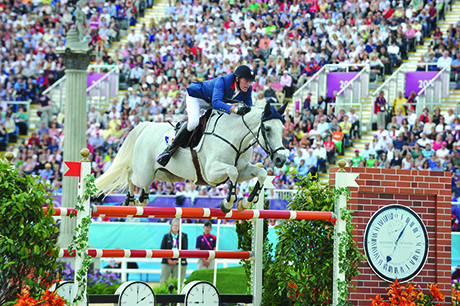
Kevin and Silvana competing in the London Games
What is Silvana like to ride?
“She is stiff like hell. Each day when you ride her, flatwork it is difficult. I know her and so I don’t try any more to make her so soft. I go a lot to the beach with her, working in the sea. Now she has a lot of experience, she has really good condition, physical condition, I work really on the good motivation from her, going out in the fields, in the sea, and when I do flatwork, I don’t do so much or so strong. I just want to keep her in a good mood – because she has no pure scope, she is not really scopey. She is a really sensitive mare, she can be hot – but she is really really careful. At the end she is not so powerful so she is doing a lot from the energy she has.”
Who will be your next big star?
“I hope a horse called Reveur de Hurtebise, Malin Baryard Johnsson was riding him before and Emmanuele and Armand bought him one and a half years ago. He had a small injury and he was out for six months, and he has just started again. I think he could be my horse for the WEG next year. He is everything of Silvana and Quick Star, plus a power body, when you see him in the stables, he has muscles, he is a strong horse, with lots of blood.”
Was it an issue for the horse to adapt from Malin’s riding to your riding?
“I always loved this horse. He was a little bit too strong for Malin in the beginning. She had been riding him since he was four years old, until he was nine, and he was always very difficult for her – but at the end, she had a lot of control. Because she had been riding him for five years they had a partnership – so it was a big change for him when I started to ride him. The first show I went to with him, was the Global Champions Tour, in the Grand Prix, so it was not the easiest way to do it. After that I slowed down and rode a few 1.40 classes, without pressure, and now after the six months break, we are ready to go, and I think he will be my best horse next year.”
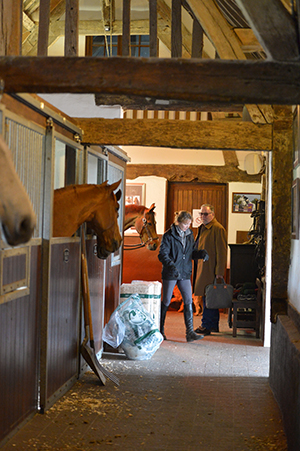
THM editor Chris Hector taking a look around the stables
There are opportunities if Australian riders would like to come to Haras de la Chesnaye to train?
“We really want to make this an attractive centre. We have nice stables and even when I move to the other stables it is only two kilometres, that’s easy with my scooter, and I can help the riders here. I am interested in training because you can learn a lot coaching different people. It is interesting to see different styles, to ride with people we are not seeing so often. You have your shows in your continent, and not so many Australian riders come to Europe, that could be new and interesting for us. We would welcome your riders.”



